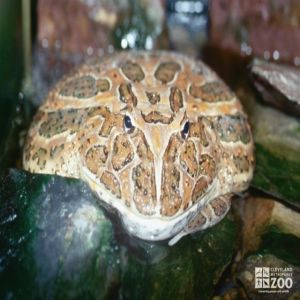Ornate Horned Frog
[Ceratophrys ornata]

Ornate Horned Frogs are large frogs, up to 10 inches in length. They are strong and pugnacious, with a huge mouth, large teeth, and a wide body. They are covered with bumpy warts on their upper sides. They are intricately colored, with geometric patterns of yellow, red, and green on a dark background (somewhat resembling a gourd!). The underside ranges from pink to yellow, and the throat is mottled in gray. The colors seem conspicuous when the frog is out of its natural habitat, (helping to serve as a warning to predators), but the color scheme blends very well into its home setting. The powerful limbs are short, the digits blunt, and an enlarged metatarsal tubercle or spade is present on each hind leg. Its eyelids are drawn up into small 'horns.' These are really just flaps of skin and not hard or sharp at all. The eyes are set as much as three times higher from the lower jaw than in most frogs, enabling this frog to completely burrow into a loose substrate with just the eyes exposed. Females are slightly longer than males.
Location: Animals Formerly at Zoo
Share:
Range
The Ornate Horned Frogs range is the Pampas region of Argentina, Uruguay, and Rio Grande do Sal, Brazil.
Habitat
Ornate Horned Frogs are usually found near rivers and swamps, and occasionally in some arid regions.
Conservation Status
Near ThreatenedPrimary Threats
Human Wildlife Coexistence, Climate ChangeGestation
Ornate Horned Frogs lay eggs which hatch into tadpoles in 18 hours.
Litter
Clutch size: 200 to 1,000 eggs
Behavior
Ornate Horned Frogs lie in ambush in mud or under leaves, concealed by camouflage, and will snap at any prey as it approaches. Even the tadpoles are predatory from the start, attacking other small animals. They like to fight, and if disturbed will attack larger animals and will even snap at humans if they try to handle them. They are able to resist droughts by burrowing in mud and forming a cocoon around their bodies by shedding several layers of their outer skin. The loose skin will still surround the frog, helping them to keep damp until the drought ends.
Reproduction
Ornate Horned Frogs engage in a process called amplexus which lasts from 1 to 4 hours, with the female depositing a tennis ball-sized clump of 200 to 1,000 1.3 millimeter eggs, which hatch in about 18 hours. The tadpoles grow quickly and are carnivorous from the start, moving in swarms to overwhelm other aquatic creatures. After 20 to 32 days the first 2-centimeter froglets begin to emerge.
Wild Diet
Birds, small mammals, frogs, insects, lizards, snakes
Zoo Diet
Mice
